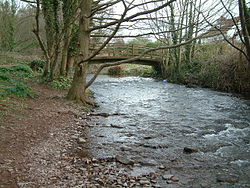| River Horner / Horner Water | |
|---|---|
 River Horner at Bossington | |
| Location | |
| Country | England |
| County | Somerset |
| Physical characteristics | |
| Source | |
| • location | near Luccombe, Somerset, England |
| • coordinates | 51°11′08″N 3°34′45″W / 51.18556°N 3.57917°W |
| Mouth | Porlock Bay, Bristol Channel |
• location | near Hurlestone Point, Somerset, England |
• coordinates | 51°13′31″N 3°35′10″W / 51.22528°N 3.58611°W |
• elevation | 0 m (0 ft) |
| Discharge | |
| • location | West Luccombe |
| • average | 0.46 m3/s (16 cu ft/s) |
| • minimum | 0.02 m3/s (0.71 cu ft/s)23 August 1976 |
| • maximum | 11.3 m3/s (400 cu ft/s)18 December 1993 |
| Basin features | |
| Tributaries | |
| • right | River Aller |
The River Horner, also known as Horner Water, rises near Luccombe on Exmoor, Somerset, and flows past Porlock into Porlock Bay near Hurlstone Point on the Bristol Channel. [1] [2] The river flows into the sea though a shingle ridge at Bossington beach, where it forms part of the Porlock Ridge and Saltmarsh Site of Special Scientific Interest. [3] When the river level is very high, flood water builds up behind the ridge, causing it to breach. [4]
Evidence that the river was previously diverted to power iron workings has been found. The remains of an iron hammer mill and 55m long, breached, embankment dam were excavated alongside the river in 1996. [5] [6]
- ^ "Horner Water". Somerset Rivers. Retrieved 18 February 2021.
- ^ "River Horner". Exmoor Waters. Retrieved 18 February 2021.
- ^ "Landscape Character Assessment of Exmoor" (pdf). Exmoor National Park Authority. p. 120. Retrieved 18 February 2021.
- ^ "Volume of water proves too much for pebble ridge". West Somerset Free Press. 14 May 2012. Retrieved 18 February 2021.
- ^ Naomi Cudmore (12 June 2014). "Past Times: Horner Woods". Exmoor Magazine. Retrieved 18 February 2021.
- ^ "MSO7424 - Medieval and post-medieval iron working site and iron hammer mill in Horner Wood (Monument)". The Historic Environment Record for Exmoor National Park. Exmoor National Park Authority. Retrieved 18 February 2021.
| River Horner / Horner Water | |
|---|---|
 River Horner at Bossington | |
| Location | |
| Country | England |
| County | Somerset |
| Physical characteristics | |
| Source | |
| • location | near Luccombe, Somerset, England |
| • coordinates | 51°11′08″N 3°34′45″W / 51.18556°N 3.57917°W |
| Mouth | Porlock Bay, Bristol Channel |
• location | near Hurlestone Point, Somerset, England |
• coordinates | 51°13′31″N 3°35′10″W / 51.22528°N 3.58611°W |
• elevation | 0 m (0 ft) |
| Discharge | |
| • location | West Luccombe |
| • average | 0.46 m3/s (16 cu ft/s) |
| • minimum | 0.02 m3/s (0.71 cu ft/s)23 August 1976 |
| • maximum | 11.3 m3/s (400 cu ft/s)18 December 1993 |
| Basin features | |
| Tributaries | |
| • right | River Aller |
The River Horner, also known as Horner Water, rises near Luccombe on Exmoor, Somerset, and flows past Porlock into Porlock Bay near Hurlstone Point on the Bristol Channel. [1] [2] The river flows into the sea though a shingle ridge at Bossington beach, where it forms part of the Porlock Ridge and Saltmarsh Site of Special Scientific Interest. [3] When the river level is very high, flood water builds up behind the ridge, causing it to breach. [4]
Evidence that the river was previously diverted to power iron workings has been found. The remains of an iron hammer mill and 55m long, breached, embankment dam were excavated alongside the river in 1996. [5] [6]
- ^ "Horner Water". Somerset Rivers. Retrieved 18 February 2021.
- ^ "River Horner". Exmoor Waters. Retrieved 18 February 2021.
- ^ "Landscape Character Assessment of Exmoor" (pdf). Exmoor National Park Authority. p. 120. Retrieved 18 February 2021.
- ^ "Volume of water proves too much for pebble ridge". West Somerset Free Press. 14 May 2012. Retrieved 18 February 2021.
- ^ Naomi Cudmore (12 June 2014). "Past Times: Horner Woods". Exmoor Magazine. Retrieved 18 February 2021.
- ^ "MSO7424 - Medieval and post-medieval iron working site and iron hammer mill in Horner Wood (Monument)". The Historic Environment Record for Exmoor National Park. Exmoor National Park Authority. Retrieved 18 February 2021.